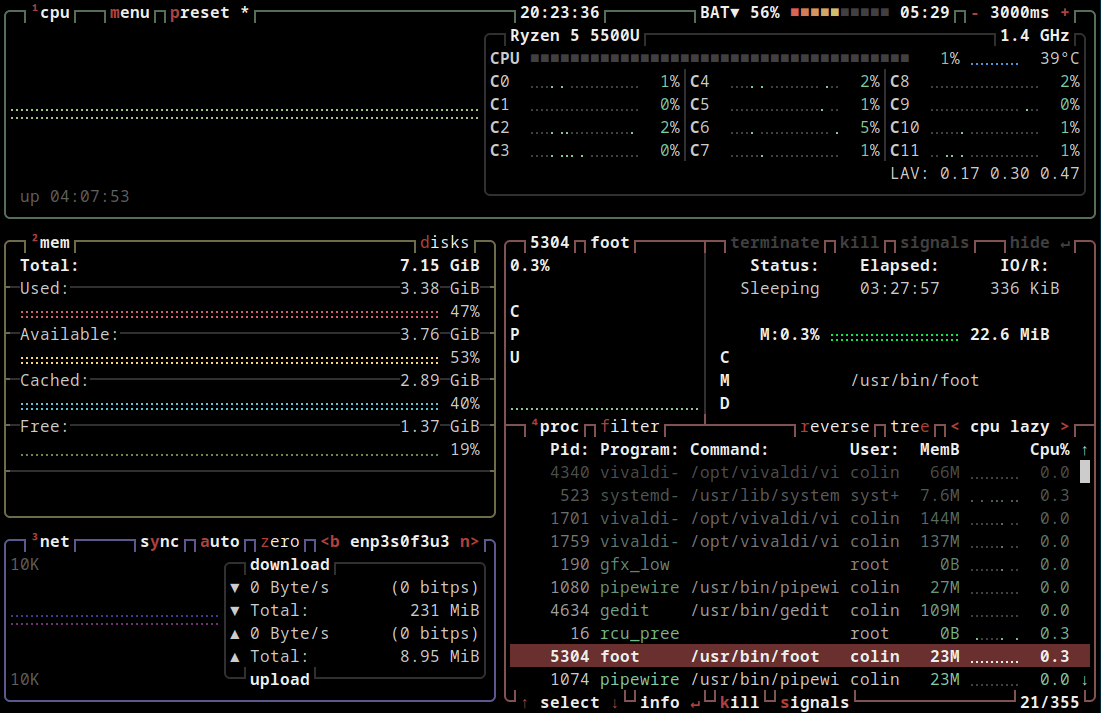Earlier I posted this Linux & Tech news 📰 - #1253 by Colin which has a link to the 26 Best Free Linux Terminal Emulators.
I decided to give the foot terminal a try...
... and I'm highly impressed with how few resources it uses - it uses <1% of my CPU and only 23MB RAM. Here's a btop screenshot showing foot's frugality:
This is one of the few YouTube videos I found about it:
I've had a look at how it should be configured...
https://man.archlinux.org/man/foot.ini.5.en
...but it has left me baffled.
Can anyone sort the following config file for use with Garuda? I'm not looking for anything complex, just the basics.
# -*- conf -*-
# shell=$SHELL (if set, otherwise user's default shell from /etc/passwd)
# term=foot (or xterm-256color if built with -Dterminfo=disabled)
# login-shell=no
# app-id=foot
# title=foot
# locked-title=no
# font=monospace:size=8
# font-bold=<bold variant of regular font>
# font-italic=<italic variant of regular font>
# font-bold-italic=<bold+italic variant of regular font>
# font-size-adjustment=0.5
# line-height=<font metrics>
# letter-spacing=0
# horizontal-letter-offset=0
# vertical-letter-offset=0
# underline-offset=<font metrics>
# underline-thickness=<font underline thickness>
# box-drawings-uses-font-glyphs=no
# dpi-aware=auto
# initial-window-size-pixels=700x500 # Or,
# initial-window-size-chars=<COLSxROWS>
# initial-window-mode=windowed
# pad=0x0 # optionally append 'center'
# resize-delay-ms=100
# notify=notify-send -a ${app-id} -i ${app-id} ${title} ${body}
# bold-text-in-bright=no
# word-delimiters=,│`|:"'()[]{}<>
# selection-target=primary
# workers=<number of logical CPUs>
# utempter=/usr/lib/utempter/utempter
[environment]
# name=value
[bell]
# urgent=no
# notify=no
# command=
# command-focused=no
[scrollback]
# lines=1000
# multiplier=3.0
# indicator-position=relative
# indicator-format=""
[url]
# launch=xdg-open ${url}
# label-letters=sadfjklewcmpgh
# osc8-underline=url-mode
# protocols=http, https, ftp, ftps, file, gemini, gopher
# uri-characters=abcdefghijklmnopqrstuvwxyzABCDEFGHIJKLMNOPQRSTUVWXYZ0123456789-_.,~:;/?#@!$&%*+="'()[]
[cursor]
# style=block
# color=<inverse foreground/background>
# blink=no
# beam-thickness=1.5
# underline-thickness=<font underline thickness>
[mouse]
# hide-when-typing=no
# alternate-scroll-mode=yes
[colors]
# alpha=1.0
# background=002b36
# foreground=839496
## Normal/regular colors (color palette 0-7)
# regular0=073642 # black
# regular1=dc322f # red
# regular2=859900 # green
# regular3=b58900 # yellow
# regular4=268bd2 # blue
# regular5=d33682 # magenta
# regular6=2aa198 # cyan
# regular7=eee8d5 # white
## Bright colors (color palette 8-15)
# bright0=08404f # bright black
# bright1=e35f5c # bright red
# bright2=9fb700 # bright green
# bright3=d9a400 # bright yellow
# bright4=4ba1de # bright blue
# bright5=dc619d # bright magenta
# bright6=32c1b6 # bright cyan
# bright7=ffffff # bright white
## dimmed colors (see foot.ini(5) man page)
# dim0=<not set>
# ...
# dim7=<not-set>
## The remaining 256-color palette
# 16 = <256-color palette #16>
# ...
# 255 = <256-color palette #255>
## Misc colors
# selection-foreground=<inverse foreground/background>
# selection-background=<inverse foreground/background>
# jump-labels=<regular0> <regular3> # black-on-yellow
# scrollback-indicator=<regular0> <bright4> # black-on-bright-blue
# search-box-no-match=<regular0> <regular1> # black-on-red
# search-box-match=<regular0> <regular3> # black-on-yellow
# urls=<regular3>
[csd]
# preferred=server
# size=26
# font=<primary font>
# color=<foreground color>
# hide-when-typing=no
# border-width=0
# border-color=<csd.color>
# button-width=26
# button-color=<background color>
# button-minimize-color=<regular4>
# button-maximize-color=<regular2>
# button-close-color=<regular1>
[key-bindings]
# scrollback-up-page=Shift+Page_Up
# scrollback-up-half-page=none
# scrollback-up-line=none
# scrollback-down-page=Shift+Page_Down
# scrollback-down-half-page=none
# scrollback-down-line=none
# clipboard-copy=Control+Shift+c XF86Copy
# clipboard-paste=Control+Shift+v XF86Paste
# primary-paste=Shift+Insert
# search-start=Control+Shift+r
# font-increase=Control+plus Control+equal Control+KP_Add
# font-decrease=Control+minus Control+KP_Subtract
# font-reset=Control+0 Control+KP_0
# spawn-terminal=Control+Shift+n
# minimize=none
# maximize=none
# fullscreen=none
# pipe-visible=[sh -c "xurls | fuzzel | xargs -r firefox"] none
# pipe-scrollback=[sh -c "xurls | fuzzel | xargs -r firefox"] none
# pipe-selected=[xargs -r firefox] none
# show-urls-launch=Control+Shift+u
# show-urls-copy=none
# show-urls-persistent=none
# prompt-prev=Control+Shift+z
# prompt-next=Control+Shift+x
# unicode-input=none
# noop=none
[search-bindings]
# cancel=Control+g Control+c Escape
# commit=Return
# find-prev=Control+r
# find-next=Control+s
# cursor-left=Left Control+b
# cursor-left-word=Control+Left Mod1+b
# cursor-right=Right Control+f
# cursor-right-word=Control+Right Mod1+f
# cursor-home=Home Control+a
# cursor-end=End Control+e
# delete-prev=BackSpace
# delete-prev-word=Mod1+BackSpace Control+BackSpace
# delete-next=Delete
# delete-next-word=Mod1+d Control+Delete
# extend-to-word-boundary=Control+w
# extend-to-next-whitespace=Control+Shift+w
# clipboard-paste=Control+v Control+Shift+v Control+y XF86Paste
# primary-paste=Shift+Insert
# unicode-input=none
[url-bindings]
# cancel=Control+g Control+c Control+d Escape
# toggle-url-visible=t
[text-bindings]
# \x03=Mod4+c # Map Super+c -> Ctrl+c
[mouse-bindings]
# selection-override-modifiers=Shift
# primary-paste=BTN_MIDDLE
# select-begin=BTN_LEFT
# select-begin-block=Control+BTN_LEFT
# select-extend=BTN_RIGHT
# select-extend-character-wise=Control+BTN_RIGHT
# select-word=BTN_LEFT-2
# select-word-whitespace=Control+BTN_LEFT-2
# select-row=BTN_LEFT-3
# vim: ft=dosini
